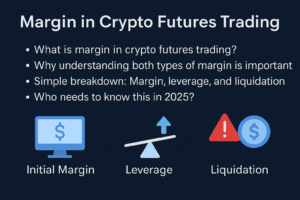Crypto is often considered secure because it is based on blockchain technology. This technology makes transactions immutable, meaning once a transaction is recorded, it cannot be changed.
The idea is that transactions are transparent and visible to everyone, which makes it hard to alter or hack. This is why people perceive crypto as a safe and tamper-proof way to manage and store their assets.
What’s Hidden Beneath the Surface
However, this perception is not entirely accurate. While blockchain is secure in many ways, it doesn’t eliminate all risks. The major risks lie in the exchanges where people store their crypto. If these exchanges get hacked, you can lose all your funds. In addition, poorly written smart contracts or fraud schemes targeting individuals can lead to significant losses, even if the blockchain itself is secure.
The Rise of Cryptocurrency: A Double-Edged Sword
Global Surge in Adoption
The use of cryptocurrency is rapidly growing around the world. People are using it for trading, investment, and even everyday transactions. The appeal comes from the fact that users have control over their assets without relying on banks or financial institutions. This independence and the potential for high returns are key reasons for the surge in popularity.
The Growing Appeal and Risks of DeFi
Decentralized Finance (DeFi) allows people to perform financial transactions without relying on traditional banks. The appeal of DeFi lies in the higher control it offers and the potential for better returns. However, there are risks involved as well. If smart contracts are not properly coded or there are liquidity issues, people can lose their money. Therefore, participating in DeFi requires careful consideration and understanding of the risks.

The Hidden Risks of Digital Wallets
Hot Wallets vs Cold Wallets: What’s the Difference?
Digital wallets are essential for managing cryptocurrencies, and they come in two main types: hot wallets and cold wallets.
- Hot Wallets are connected to the internet, making them convenient for quick transactions. However, their connection to the web also makes them vulnerable to hacking. Examples include mobile apps and online wallets.
- Cold Wallets are offline, providing a much higher level of security. These wallets are stored on hardware devices or paper and are only connected to the internet when necessary, making them less prone to attacks.
Vulnerabilities in Online Wallets and Their Exposure to Hacks
Online wallets, or hot wallets, are more vulnerable to cyber-attacks. Since they are always connected to the internet, hackers can target them more easily through phishing, malware, or other malicious attacks. If you store large amounts of cryptocurrency in a hot wallet, you’re putting your assets at higher risk, especially if you’re not using strong security measures like two-factor authentication or encryption.
What’s at Stake If Your Private Keys Are Compromised?
Private keys are the secret codes that allow you to access and manage your cryptocurrency. If someone gains access to your private keys, they can fully control your crypto assets. Without the ability to reverse transactions on blockchain networks, if your private keys are stolen or compromised, your funds are gone. There’s no central authority to help recover lost or stolen crypto, which makes it crucial to securely store and back up your private keys.
Exchange Hacks: Are Your Funds Really Safe?
High-Profile Hacks: Mt. Gox, Bitfinex, and Others
Crypto exchanges have been frequent targets for high-profile hacks, causing massive financial losses. Some notable examples include:
- Mt. Gox: One of the largest exchanges in the early days of Bitcoin, Mt. Gox was hacked in 2014, losing around 850,000 Bitcoins. The breach led to the exchange’s bankruptcy and highlighted the risks of trusting centralized exchanges with large amounts of crypto.
- Bitfinex: In 2016, Bitfinex, one of the largest exchanges at the time, was hacked, resulting in the theft of 120,000 Bitcoins. Despite the hack, the exchange continued operations, but the incident raised concerns about the security of funds stored on exchanges.
These hacks have shown that no exchange, regardless of size or reputation, is immune to security breaches.
Security Flaws Within Crypto Exchanges and How They Affect Users
Crypto exchanges are prime targets for hackers due to the valuable assets they hold. Many exchanges have security flaws, such as weak encryption, poor user authentication systems, or vulnerabilities in their software that make them susceptible to attacks. If a hacker gains access to an exchange’s database or internal systems, they could steal funds, and often, users can’t recover their stolen assets because exchanges don’t guarantee 100% protection.

Additionally, many exchanges store users’ funds in hot wallets, making them more vulnerable to attacks. Without robust security measures, users’ assets can be at significant risk.
How to Protect Yourself from Exchange Vulnerabilities
While exchange hacks are a threat, you can take steps to minimize the risk to your funds:
- Use hardware wallets: Instead of keeping all your crypto on exchanges, store your funds in cold storage using hardware wallets (like Ledger or Trezor), which are offline and less vulnerable to hacking.
- Enable two-factor authentication (2FA): Always enable 2FA on your exchange account to add an extra layer of protection. This ensures that even if someone gains access to your password, they cannot log in without the second factor.
- Withdraw funds when not trading: If you’re not actively trading, it’s safer to withdraw your funds from the exchange to a personal wallet. This way, your funds are less exposed to potential hacks.
- Use reputable exchanges: Always choose exchanges with a solid reputation and robust security measures in place, such as insurance on stored funds or a history of secure operations.
By taking these precautions, you can reduce your exposure to exchange hacks and better protect your digital assets.
Smart Contract Vulnerabilities
Explaining the Concept of Smart Contracts and Their Role in DeFi
Smart contracts are self-executing contracts with the terms of the agreement directly written into code. They automatically execute and enforce the terms of a contract when certain conditions are met, without needing intermediaries like lawyers or banks. Smart contracts play a major role in Decentralized Finance (DeFi), allowing users to engage in financial activities (like lending, borrowing, or trading) without relying on traditional financial institutions. However, they are only as secure as the code they are written with.
Common Security Flaws in Smart Contracts and High-Profile Hacks
Despite the promise of smart contracts, they have vulnerabilities that can be exploited by hackers. Some common security flaws include:
- Reentrancy Attacks: A hacker can exploit a vulnerability in the contract to repeatedly call the contract’s function and drain funds before the contract’s state is updated, as seen in the infamous DAO hack of 2016, which led to a loss of millions of dollars.
- Integer Overflow and Underflow: These occur when the contract fails to correctly handle arithmetic calculations, allowing attackers to manipulate values and exploit the contract.
- Uninitialized Variables: If a smart contract contains uninitialized or improperly initialized variables, attackers can take advantage of this to alter the behavior of the contract.
- Access Control Flaws: These flaws occur when a smart contract allows unauthorized users to access certain features or alter critical data, resulting in unauthorized transactions.

High-profile hacks like the bZx hack (2020) and Poly Network hack (2021) were caused by such vulnerabilities, leading to millions of dollars in stolen funds.
How to Avoid Risky Contracts and What to Look Out For
While smart contracts have become a staple in DeFi, it’s crucial to exercise caution. Here’s how to avoid risky contracts:
- Audit the Contract Code: Ensure that the smart contract has been audited by reputable third-party firms. Audits check for common vulnerabilities and potential flaws in the code.
- Verify Contract Logic: Understand the logic and functionality of the contract. If you’re not a developer, consider seeking help from an expert to review the code for potential issues.
- Use Trusted Platforms: Stick to well-known and reputable DeFi platforms that have a history of secure smart contracts. Avoid new or unverified platforms, as they may have untested or faulty contracts.
- Limit Exposure: Avoid locking large amounts of funds in a single contract or DeFi project. Diversify your investments and only commit the amount you’re willing to lose.
- Check for Proper Access Control: Ensure that the contract includes mechanisms to prevent unauthorized access or changes to critical functions, especially those that control user funds.
By staying informed and vigilant, you can significantly reduce your exposure to risky smart contracts and the vulnerabilities that come with them.
Phishing and Social Engineering Attacks
What Phishing Scams Look Like in the Crypto World
Phishing is a type of cyber attack where scammers trick individuals into revealing sensitive information like passwords, private keys, or recovery phrases. In the crypto world, phishing scams can take various forms:
- Fake Websites: Scammers create fake websites that look similar to legitimate crypto exchanges or wallet platforms. When users log in, their credentials are stolen.
- Phishing Emails: Scammers send emails that appear to be from trusted crypto services, asking you to click on a link to verify your account or reset your password. The link leads to a fake site where your credentials are captured.
- Fake Support Requests: Scammers may contact you pretending to be customer support from an exchange or wallet service, asking you to provide sensitive information or make an urgent transaction.
How Social Engineering is Used to Steal Your Crypto
Social engineering is the manipulation of people into divulging confidential information. In the crypto world, social engineering attacks can be quite sophisticated:
- Impersonation: Attackers may pose as someone you trust, such as a friend, colleague, or support agent from a crypto platform, and request that you send them crypto or provide personal details.
- Urgency and Fear Tactics: Scammers often create a sense of urgency, such as claiming that your account is at risk or that a limited-time opportunity is available. This pressures you into making quick decisions without carefully verifying the situation.
- Fake Airdrops or Giveaways: Scammers may advertise fake giveaways or airdrops, asking users to send crypto or private keys in exchange for rewards, which never come.

Tips to Avoid Falling for These Common Tricks
To protect yourself from phishing and social engineering attacks, follow these best practices:
- Double-Check URLs: Always verify the URL of any crypto-related website, especially when entering sensitive information. Make sure the website is the official one and that it starts with “https://.”
- Don’t Click on Suspicious Links: Be cautious of unsolicited emails, messages, or links that urge immediate action. Always go directly to the official website rather than clicking on links in emails or messages.
- Enable Two-Factor Authentication (2FA): 2FA adds an extra layer of security by requiring something you know (your password) and something you have (your phone or authentication app).
- Be Skeptical of Urgent Requests: Always question any urgent requests to send crypto or reveal personal information. Take time to verify the request through official channels before acting.
- Educate Yourself: Stay informed about the latest phishing techniques and social engineering scams. Recognizing the signs of a scam can help you avoid falling victim to one.
By staying alert and practicing good security hygiene, you can minimize the risk of phishing and social engineering attacks and protect your crypto assets.
Regulatory Risks: What Governments Are Hiding
How Different Countries Are Regulating or Banning Crypto
The regulatory landscape for cryptocurrency varies greatly across countries, with some embracing it while others seek to control or ban it entirely.
- Countries that embrace crypto: Some countries, like Switzerland and Singapore, have established clear and favorable regulations for crypto. These countries allow crypto trading, investment, and even the creation of blockchain-based businesses with minimal interference.
- Countries with strict regulations: China has imposed a total ban on cryptocurrency trading and mining, citing concerns over financial stability and environmental impact. Similarly, India has had ongoing debates about regulating or imposing a heavy tax burden on crypto activities.
- Countries banning or restricting crypto: Countries like Algeria and Bolivia have outright banned cryptocurrencies, while others like Russia have implemented strict regulations, such as requiring crypto transactions to be reported to authorities.
The Impact of Government Policies on Your Crypto Security
Government policies can have a significant effect on the security and stability of your crypto holdings. Here’s how:
- Exchanges and Financial Institutions: If a government suddenly imposes regulations or bans on crypto, it can cause exchanges and financial institutions to shut down, which may block access to your funds. For example, if a country bans crypto trading, local exchanges may be forced to cease operations, making it difficult for residents to withdraw or convert their holdings.
- Confiscation or Freezing of Assets: In some countries, the government could seize or freeze crypto assets under certain laws or emergency powers. If your crypto is stored in a regulated exchange that falls under government control, there’s a risk that your funds could be frozen or confiscated during times of political instability or regulatory crackdowns.
- Uncertainty and Volatility: Frequent changes in government policies or unclear regulatory frameworks can create uncertainty, causing market volatility. If you live in a country where regulations are inconsistent or unclear, this could affect your investment strategy and the long-term value of your crypto assets.
What’s Being Hidden from the Public Regarding Crypto Regulations
While governments and regulatory bodies make headlines about cracking down on crypto, there’s often more beneath the surface that may not be publicized:
- Political or Economic Motivations: Some governments may restrict or regulate crypto to control the economy, maintain power over the financial system, or protect national currencies. In some cases, countries may even ban crypto because it poses a threat to their own financial systems or currencies.
- Regulatory Gaps: While some governments propose strict regulations, there is often a lack of enforcement mechanisms, leaving loopholes for fraud, scams, and bad actors to thrive. These regulatory gaps are often hidden from the public, allowing businesses and individuals to bypass the law.
- Corporate Influence: In some cases, large financial institutions or corporations may influence regulations in their favor, pushing for policies that limit decentralized finance or crypto in order to protect their business models. The influence of lobbyists and industry giants is often not transparent, leaving the public unaware of its impact on regulatory decisions.

By understanding these hidden aspects of crypto regulations, investors can better prepare for the potential risks and adapt their strategies accordingly. Keeping an eye on local and global regulatory developments can help you stay informed about the future of crypto.
The Dark Side of Decentralization
Decentralized Finance (DeFi) and Its Potential Risks
Decentralized Finance (DeFi) aims to offer financial services without relying on traditional intermediaries like banks. While this sounds appealing for those seeking more control over their assets, it also introduces significant risks:
- Smart Contract Vulnerabilities: DeFi platforms rely heavily on smart contracts, which are susceptible to coding errors or hacks. Exploits in these contracts can lead to significant financial losses for users, as seen in previous high-profile DeFi hacks.
- Scams and Fraud: Due to the lack of regulation and oversight in DeFi, bad actors often exploit this space by creating fake projects, exit scams, or Ponzi schemes. Users are often unable to recover funds if they fall victim to these scams.
- Lack of Consumer Protection: In traditional finance, consumers have certain protections, like insurance on deposits or legal recourse for fraud. In DeFi, these protections are virtually non-existent, leaving users exposed to losses with little to no chance of recovery.
Lack of Consumer Protection in Decentralized Exchanges
Decentralized exchanges (DEXs) allow users to trade cryptocurrencies without relying on a central authority. While this offers greater privacy and security, it also comes with serious risks:
- No Customer Support: If you lose access to your funds or encounter a problem, there’s no customer support team to help you recover your assets. You’re essentially on your own.
- No Recourse for Disputes: If something goes wrong in a trade or with a smart contract on a DEX, there’s no regulatory body or legal system to turn to. This means that users have to bear all the risks without any safety nets.
- Increased Exposure to Hacks: While DEXs are generally considered more secure than centralized exchanges, they still have vulnerabilities, such as smart contract flaws or liquidity issues, which can be exploited by hackers.
How Being Your Own Bank Can Backfire
The idea of being your own bank, which is central to the appeal of DeFi, can be empowering, but it also carries significant risks:
- Responsibility for Security: When you store your own crypto, you are responsible for securing it. If you lose your private keys or recovery phrases, there’s no one who can help you retrieve your assets. Unlike a bank, which offers a backup system for lost access, crypto users have to rely on their own security practices.
- Lack of Insurance: Traditional banks often provide insurance on deposits (like FDIC in the U.S.). In crypto, if your funds are stolen or lost due to a mistake or hack, there’s no insurance policy to protect you. You’re fully responsible for safeguarding your assets.
- Complexity and Risk of Errors: Managing crypto wallets, transactions, and security measures can be complicated. A simple mistake, like sending funds to the wrong address or interacting with a malicious contract, can lead to irreversible losses.
While decentralization offers many benefits, it’s important to be aware of these risks and take proper precautions to protect yourself in the decentralized world.
Scams, Rug Pulls, and Ponzi Schemes
How to Identify and Avoid Crypto Scams and Ponzi Schemes
Crypto scams, Ponzi schemes, and rug pulls are unfortunately common in the cryptocurrency world. Here’s how you can spot them:
- Unrealistic Promises: If a project promises guaranteed returns or “too good to be true” opportunities, it’s likely a scam. Legitimate projects can’t promise high, consistent returns with no risk.
- Lack of Transparency: If the project lacks clear information about its team, business plan, or roadmap, it’s a red flag. Legitimate crypto projects are transparent about who’s behind them and their goals.
- Pressure to Act Quickly: Scammers often create a sense of urgency, pushing you to invest quickly before you miss out. They might say there’s a limited-time offer or a “once-in-a-lifetime” opportunity. Take your time and do thorough research.
- Anonymous Teams: If the project’s team members are hidden or using fake identities, it’s a huge warning sign. Real, trustworthy projects are usually open about who’s behind them.
- Overly Complex or Unclear Whitepapers: A whitepaper should clearly explain the project’s purpose, technology, and how it plans to succeed. If it’s filled with jargon or lacks substance, the project may be dishonest.
Recent Examples of Rug Pulls and Their Consequences
Rug pulls occur when the creators of a crypto project suddenly withdraw all the liquidity or funds from a platform, leaving investors with worthless tokens. Here are a couple of high-profile examples:
- Squid Game Token (2021): This project, inspired by the popular Netflix show, gained massive attention and quickly rose in value. However, the creators performed a rug pull by draining $3.38 million from the liquidity pool, causing the token’s price to crash to near-zero. Many investors lost their entire investments.
- FOMO Coin (2021): FOMO Coin was marketed as a high-return investment opportunity. After attracting substantial funds from investors, the developers pulled out, taking millions of dollars. The investors were left with worthless tokens, and the project disappeared without a trace.
These rug pulls highlight the risks involved with unverified projects and emphasize the importance of due diligence.
Protecting Yourself from Dishonest Projects and Coins
To protect yourself from scams, rug pulls, and Ponzi schemes, follow these tips:
- Do Thorough Research: Always research the project thoroughly before investing. Look for audits, read the whitepaper, and check if the project has a verified team. Avoid projects with no proven track record or that lack transparency.
- Avoid Investing Based on Hype: Don’t invest just because a project is getting a lot of social media attention or is endorsed by influencers. Hype can be manipulated to create a false sense of security.
- Check for Audits: Ensure that the project’s code has been audited by a reputable third-party firm. Audits help detect potential vulnerabilities in the code that could be exploited by scammers.
- Be Cautious of New Tokens: New tokens with no proven use case or clear development roadmap are high-risk investments. Stick with established, well-known projects until you gain more experience in the space.
- Diversify Your Portfolio: Don’t put all your money into one project. Diversifying your investments reduces the potential damage if one project turns out to be a scam.
By being vigilant and following these strategies, you can protect yourself from falling victim to scams and avoid losing your hard-earned money.

How to Keep Your Crypto Safe: Best Practices
Importance of Private Keys and Backup Methods
Private keys are the most critical element for securing your cryptocurrency. They provide access to your funds, and losing them means losing control of your assets.
- Never Share Your Private Keys: Keep your private keys confidential. Sharing them or storing them in insecure locations (like online storage) can expose you to theft.
- Backup Your Keys: Always back up your private keys in multiple secure locations. Use encrypted USB drives, hardware wallets, or paper backups. Consider using multi-signature wallets, which require more than one key for transactions, adding an extra layer of security.
- Use a Safe: Store physical copies of your backup in a safe place, such as a bank safety deposit box, where they can’t be easily accessed by unauthorized individuals.
Using Hardware Wallets for Added Security
Hardware wallets, such as Ledger or Trezor, are one of the safest ways to store cryptocurrency.
- Offline Storage: Hardware wallets store your private keys offline, making them nearly immune to online hacking attempts, malware, and phishing scams. This offline feature is essential for long-term storage of crypto assets.
- Physical Device: These wallets are physical devices that require a PIN code to access. Even if your computer is compromised, your hardware wallet remains secure.
- Backup and Recovery: Hardware wallets provide a recovery phrase (usually 12-24 words) to restore your wallet if the device is lost or damaged. Be sure to write down and store the recovery phrase in a secure place.
Two-Factor Authentication and Other Safety Measures
Two-factor authentication (2FA) is a must for securing your online accounts, including exchanges and wallets.
- Enable 2FA: Use 2FA on all crypto exchanges, wallets, and platforms. This adds an extra layer of protection, requiring both your password and a code from your phone or authenticator app to access your account.
- Use Authenticator Apps: Instead of relying on SMS-based 2FA, which can be vulnerable to SIM swapping attacks, use apps like Google Authenticator or Authy for generating time-based codes.
- Strong, Unique Passwords: Use long and unique passwords for every crypto account. Avoid reusing passwords across multiple sites and enable a password manager for safe storage.
- Cold Storage: For long-term holdings, avoid storing funds on exchanges. Use cold storage (hardware wallets or paper wallets) to keep your crypto safe and away from online threats.
Trusted Platforms for Buying, Selling, and Storing Crypto
When choosing platforms for buying, selling, or storing your cryptocurrency, it’s crucial to use trusted and reputable ones.
- Well-Known Exchanges: Stick to major, well-established exchanges like Coinbase, Binance, or Kraken, which have a solid track record of security and user protection. Check for their security features such as insurance, 2FA, and cold storage of assets.
- Research New Platforms: If you’re using a newer exchange or wallet, look for reviews, user experiences, and security audits to ensure it’s trustworthy. Be cautious with platforms that don’t have transparency about their security practices.
- Avoid Unregulated Platforms: Unregulated or unknown platforms may lack the security and consumer protections you need. Always ensure that the platform you’re using complies with relevant local regulations.
By following these best practices, you can significantly enhance the security of your crypto assets and reduce the risks associated with theft and hacking. Always stay vigilant and prioritize safety in your crypto dealings.
The Future of Crypto Security: Is Your Crypto Truly Safe?
Upcoming Technologies to Secure Digital Assets
The future of crypto security is rapidly evolving, with new technologies aimed at improving the safety of digital assets. Some promising advancements include:
- Quantum-Resistant Cryptography: As quantum computing continues to progress, it poses a potential threat to traditional cryptographic methods used in blockchain and cryptocurrencies. To address this, researchers are developing quantum-resistant algorithms that would make crypto networks more secure against quantum attacks. These new algorithms aim to protect private keys and transactions from quantum-based decryption methods.
- Decentralized Identity Solutions: Future technologies may introduce decentralized identity systems, where users control their own identities without relying on centralized authorities. This would reduce the risk of identity theft, phishing attacks, and fraudulent activities. By using blockchain to verify identities, users can securely authenticate themselves without revealing unnecessary personal information.
- Zero-Knowledge Proofs (ZKPs): ZKPs allow one party to prove to another that they know a piece of information (such as a private key) without revealing the information itself. In the future, ZKPs could be used to enhance privacy and security for crypto transactions, making it harder for hackers to trace or intercept sensitive data.

What Advancements Are Being Made in Blockchain and Wallet Security
Blockchain and wallet security are constantly evolving to stay ahead of cyber threats. Some key advancements include:
- Layer 2 Solutions: Technologies like Lightning Network (for Bitcoin) and Optimistic Rollups (for Ethereum) are designed to improve transaction speed and reduce costs while maintaining the security of the underlying blockchain. These solutions enhance scalability and reduce the attack surface by offloading transactions from the main blockchain to secondary layers, which can be more efficient and secure.
- Multisignature Wallets: Multisignature (multisig) wallets are gaining popularity for added security. With a multisig wallet, more than one private key is required to authorize a transaction. This reduces the chances of theft or unauthorized access, as it requires multiple parties or devices to sign off on a transaction.
- Biometric and Multi-Factor Authentication: Biometric security, such as fingerprint or facial recognition, is being integrated into crypto wallets and exchanges. Combined with traditional 2FA methods, biometrics provide an extra layer of protection, ensuring that only authorized users can access their assets.
- Self-Custody Wallets: As more users seek control over their own funds, self-custody wallets, which allow users to securely store their crypto without third-party involvement, are becoming more user-friendly and feature-rich. Future developments will likely focus on enhancing ease of use and security, including backup methods and recovery solutions for lost or compromised keys.
Can Crypto Ever Be Fully Secure? Insights for the Future
While crypto security is improving, it’s unlikely that crypto can ever be fully secure, mainly due to:
- Human Error: No matter how advanced the technology, human error remains a significant factor in security breaches. Phishing attacks, mismanagement of private keys, and failure to use basic security practices can lead to asset loss, even if the underlying technology is robust.
- Evolving Threats: Cybersecurity is a cat-and-mouse game, where attackers constantly develop new techniques to breach systems. Even with advancements in security, hackers will always look for vulnerabilities in both blockchain technology and wallet security.
- Decentralized Nature: While decentralization offers several benefits, it also means that there is no central authority overseeing security, leaving individual users to bear the responsibility for protecting their assets. This decentralized approach can be both an advantage and a challenge for overall security.
In conclusion, while future technologies will undoubtedly make crypto more secure, achieving absolute security may never be fully possible. However, by staying informed about the latest security developments and practicing strong personal security habits, you can significantly reduce your risks and enhance the safety of your crypto assets.
Conclusion: Navigating Crypto Risks and Staying Safe
A Summary of the Main Risks and How to Mitigate Them
The world of cryptocurrency offers great opportunities but also presents significant risks. Key risks include:
- Exchange Hacks: The risk of centralized exchanges being hacked can be mitigated by using decentralized exchanges (DEXs), opting for cold storage, and ensuring your platform has strong security protocols (like 2FA).
- Wallet Vulnerabilities: Hot wallets are vulnerable to online threats, while cold wallets offer enhanced security. Hardware wallets should be used for long-term storage, and backup methods should be in place for recovery.
- Scams and Ponzi Schemes: Scams like rug pulls and Ponzi schemes can be avoided by researching projects thoroughly, looking for transparent teams, and avoiding unrealistic promises.
- Smart Contract Risks: Vulnerabilities in smart contracts can result in losses. Using audited DeFi platforms, and multi-signature wallets can minimize these risks.
- Regulatory Uncertainty: With the evolving regulatory environment, it’s important to stay informed about local and international regulations and how they could impact your investments.
How to Stay Informed About the Evolving Crypto Security Landscape
The crypto landscape is continuously changing, and staying informed is crucial. Here’s how to keep up with developments:
- Follow Reputable News Sources: Subscribe to trusted crypto news websites, such as CoinDesk, CoinTelegraph, and The Block, which regularly publish updates on security threats, regulations, and technological advancements.
- Engage with Communities: Participate in forums like Reddit’s r/CryptoSecurity, BitcoinTalk, or Twitter to learn about new risks and get real-time insights from experts and other crypto enthusiasts.
- Monitor Official Project Channels: Always follow the official communication channels of projects you’re invested in, including their website, social media, and developer updates. This will help you stay informed about potential issues and security patches.
- Regularly Review Your Security Practices: Security practices should evolve along with new threats. Periodically review your wallet security, update your passwords, and ensure that your 2FA and backup systems are up to date.
Final Thoughts on Whether Your Crypto Is Really Safe in 2025
As the crypto space matures, security is becoming more robust, but absolute security will always be a challenge. While technologies like quantum-resistant cryptography, biometric authentication, and hardware wallets are improving safety, human error, and evolving cyber threats mean that the risk is never entirely eliminated.
In 2025, crypto can be relatively safe if you adopt best practices, stay informed, and take responsibility for securing your assets. However, given the decentralized nature of the space and constant threats, it’s crucial to remain cautious and proactive in protecting your crypto. By combining technological advancements with responsible personal security habits, you can significantly reduce your exposure to risks and safeguard your digital assets.
10 FAQs About Crypto Security
1. What is the safest way to store my cryptocurrency?
The safest way to store cryptocurrency is using hardware wallets, such as Ledger or Trezor. These devices keep your private keys offline, making them secure from online hacks. For added protection, ensure you back up your recovery phrase securely.
2. What are private keys, and why are they important?
Private keys are cryptographic keys that give you access to your cryptocurrency. If someone gains access to your private keys, they can access your funds. Never share your private keys and ensure they are stored securely.
3. What is a rug pull in crypto?
A rug pull is a type of scam in the crypto world where developers of a project withdraw all funds from a liquidity pool, leaving investors with worthless tokens. Always conduct thorough research before investing in any project.
4. How can I avoid crypto scams?
To avoid scams, always:
- Research the project and its team.
- Avoid investing in projects with unrealistic returns.
- Check for independent audits of the smart contracts.
- Stick to well-known and reputable exchanges.
5. What is two-factor authentication (2FA), and should I use it?
Two-factor authentication (2FA) adds an extra layer of security to your accounts. It requires a second verification step (usually a code sent to your phone or authenticator app) in addition to your password. Always enable 2FA on exchanges and wallets.
6. Are decentralized exchanges (DEXs) safer than centralized exchanges?
Decentralized exchanges (DEXs) provide better privacy and control over your funds since they don’t hold your assets. However, they are not entirely risk-free and still have vulnerabilities. Centralized exchanges offer more features but also have a higher risk of being hacked.
7. What is a smart contract, and how secure are they?
A smart contract is a self-executing contract with terms directly written into code on the blockchain. While they are secure, vulnerabilities in the code can be exploited by hackers. Use audited smart contracts to minimize risks.
8. Can my crypto be hacked if I use a hot wallet?
Yes, hot wallets are connected to the internet, making them vulnerable to hacking. If you store large amounts of crypto, it’s safer to use a cold wallet (e.g., hardware wallet) for long-term storage.
9. What is multi-signature (multisig) security?
Multi-signature (multisig) security requires more than one key to authorize a transaction. This adds an extra layer of protection, ensuring that multiple parties must approve a transaction before funds can be moved.
10. Is crypto completely secure in 2025?
While crypto security is improving with advancements like quantum-resistant cryptography and multi-factor authentication, absolute security is impossible due to human error, evolving threats, and decentralized nature. However, adopting best security practices can significantly reduce risks.









